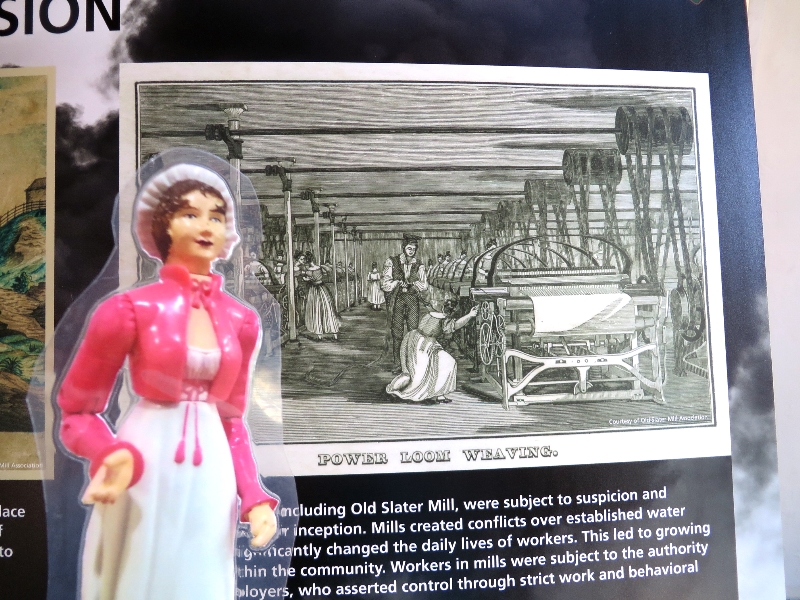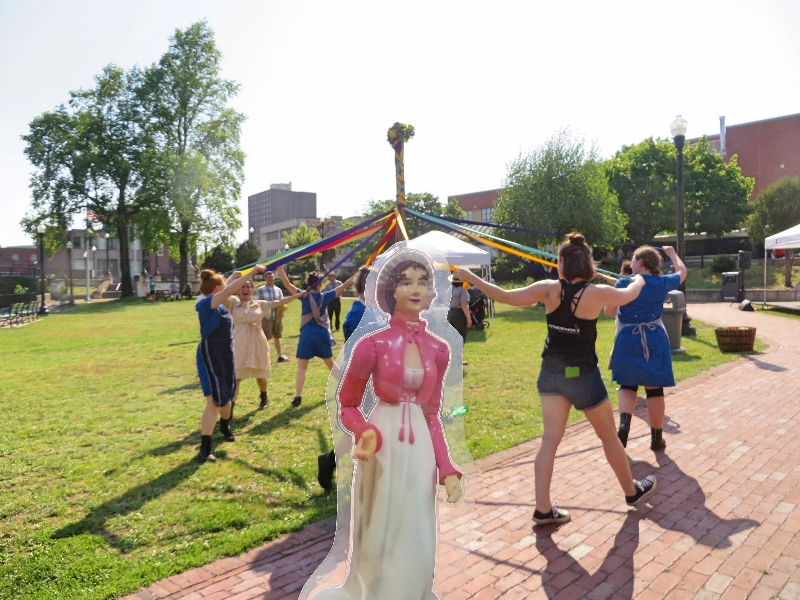Flat Jane Austen in Rhode Island:
In which she learns of the Industrial Revolution and gets a peek into the future
When the mills first opened, the workers came and went as they pleased as they were used to working with the sun and the rhythm of the seasons. This angered the mill owners who insisted on their mill hands being inside at 6 in the morning until 6 at night with only a half hour break for lunch and bathroom. For all this, the girls earned 35 cents a week and the boys 50 cents. By the year [18]10, Mr. Slater could no longer hire solely children, the machines were too powerful. He now hires young women between the ages of 15-30.
Power loom weaving was added to the Wilkinson's mill after Mr. David Wilkinson invented a powerful loom. Pawtucket has grown from a small village to a larger manufacturing town. By the 1820s, the city will have eight textile mills, six machinery manufacturers, eighty-three houses, twelve stores, two churches, a bank, two schools, the population will number 3,000 souls.
 |
| a peek into Slater's Mill in the 1820s |
I am told that the American economy is experiencing fluxuations. There will be a Panic (recession) in '19 and '24, those annoying Americans finally established their OWN taxes (Tariff of 1824) designed to protect American manufacturing. As a result of the high tariff, American manufacturers seek to keep costs low and production and profits high.
This causes great tension between the workers and the owners. Local artisans and farmers were angry over the wealthy mill owners taking all the water for their mills. Tensions boiled over in '24 when the weavers' wages were cut by 25 percent and the workday increased by one hour. The women refused to accept lower wages for more work and vowed to walk out until conditions were restored.
On May 26, 1824, 102 young women and other sympathetic community members, blocked the entrance to the hated mill. [Editor: We do not know which one.] The strike then spread to other mills.
As more people became involved, the strike turned into a riot, an unruly mob making "an excessive noise". The mob grew to 500 people. They then visited successively the houses of the manufacturers, "shouting, exclaiming and using every imaginable term of abuse and insult," according to the newspaper. Windows were broken in the mills and the owners' home and next day the manufacturers shut their gates and the mills did not run.
A compromise has been reached and as of 3 June, the workers are back at work with the same conditions as before. A clock will soon be installed in a nearby church tower.
The women express their anger in a dance.
 |
| Ah, an English country dance |
 |
| I know not what manner of dance this may be. |
 |
| Oh, a maypole dance |
 |
| A maypole dance |
Editor's Note: Slater Mill is part of the Blackstone River Valley National Historic Park. The day we went the museum was commemorating the first strike by women in the U.S. in 1824. Young women portraying mill girls performed an interpretive dance.
Please turn the page! I have yet to finish writing this letter!




No comments:
Post a Comment